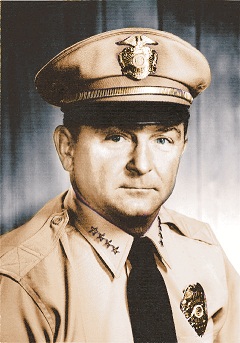With O.J. Roed on terminal leave, the City Manager picked Assistant Chief Ray Hoobler as his replacement. If he thought for a second he would be able to control him better than he could Roed, he was sorely mistaken.
Hoobler was appointed to the SDPD in 1951 and within weeks of earning his badge he was handed his first test of integrity . Responding to an alarm call at a clothing store, he saw a fellow officer steal several silk shirts. Hoobler went straight to the captain. Word quickly got out that Hoobler wasn’t one to keep his mouth shut in the presence of wrongdoing.
Another defining moment in his career came as a homicide detective. Dispatched to a murder, he was dismayed to arrive and discover a curious sergeant had tampered with the crime scene and destroyed evidence.
Hoobler said when he confronted the sergeant he was told to mind his own business.
It was then and there he vowed to make rank so that he could control what happened with his career and his police work.
Hoobler’s in your face management style made him loved by some and hated by others. Hoobler developed a reputation as a bulldog that wouldn’t back down, but at the same time, would never order an officer to do something he wasn’t willing to do himself.
That style was demonstrated at the scene of a riot in 1968 when Hoobler was leading a group of officers against a hostile crowd. Hoobler ordered his officers to remain in rank and not to individually battle the protestors. The order stood as long as it took for Hoobler to get hit with a rock and then all bets were off. Hoobler personally led the charge into the crowd as cops fought with the demonstrators.
In 1971 Hoobler was promoted to second in command after a scandal involving Assistant Chief Bob Jauregui and the Yellow Cab Company began to blossom. He was the heir apparent to take the top job when O.J. Roed retired.
At first Hoobler was excited about the job and eager to get started but it didn’t take long for him to discover what he had gotten himself into. As he was driving to work in the predawn hours Hoobler said all of a sudden it hit him he was personally responsible for the safety and well being of an entire city of more than 700,000 people. The thought caused him to pull to the side of the road as he was starting to experience chest pains.
As chief, Hoobler soon discovered what Roed already knew - life at the top can be very difficult when City Hall tries to control how the police department functions. Hoobler was clearly not the type to take orders from anyone, much less a civilian outsider on how he should run his department. That friction would cause Hoobler to become involved in a number of confrontations.
Surprisingly though it wasn’t his battles with City Hall that led to his ouster . The end came when it was revealed Hoobler had lied about looking into the confidential files of officers who had sought mental counseling. Faced with a choice of resign or be fired, the 48-year-old Hoobler stepped down. Sadly for Hoobler, he was still two years away from being old enough to collect a city pension. He quickly found work as a consultant where he testified in court on many police related issues.
Ray Hoobler died in April 2001 after a lengthy battle with cancer.

CHIEF RAYMOND L. HOOBLER (03/11/1971 - 09/09/1975)
BADGES 18, 30, 81 & 548
SDPD 04/09/1951 - 09/09/1975
08/23/1927 - 04/14/2001
